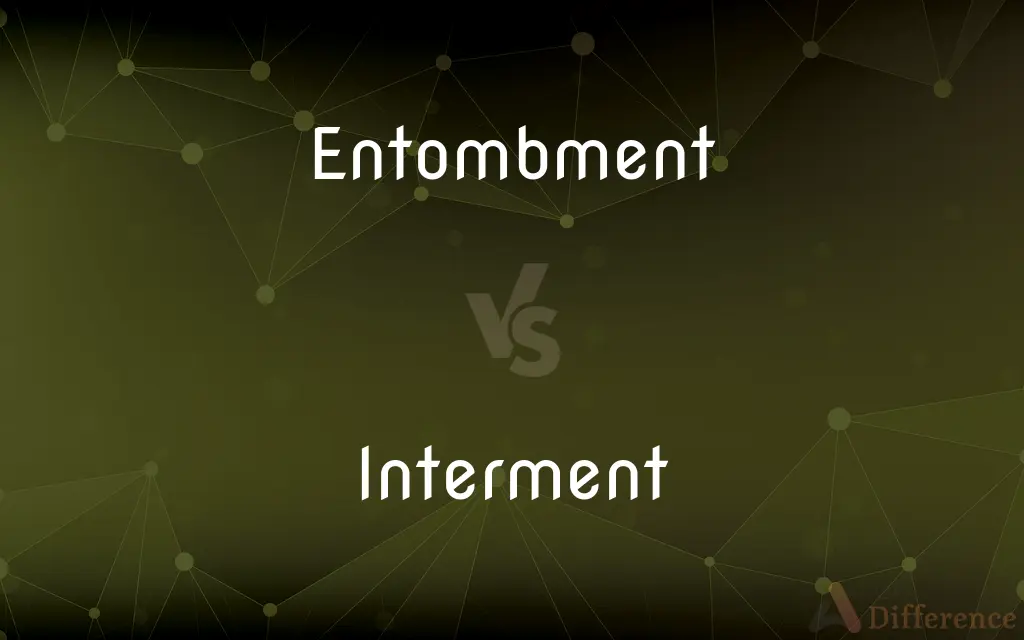Entombment vs. Interment — What's the Difference?
By Maham Liaqat & Fiza Rafique — Updated on May 2, 2024
Entombment involves placing a body in a tomb or mausoleum above ground, focusing on preservation, whereas interment refers to burial of the body underground, often in a cemetery.

Difference Between Entombment and Interment
Table of Contents
ADVERTISEMENT
Key Differences
Entombment specifically involves placing the deceased in a tomb or crypt, typically above ground. This method is chosen for its ability to preserve the body longer due to the sealed, often climate-controlled environment. On the other hand, interment involves burying the body in the earth, usually within a coffin, and is the most common method of disposing of remains.
Entombment is often more costly than interment due to the construction and maintenance of a tomb or mausoleum. Whereas interment may require less initial expense, costs can vary depending on the choice of coffin, cemetery fees, and the type of grave marker.
Culturally, entombment is associated with notions of prestige and lineage, often used by wealthy or noble families. In contrast, interment is a more universally practiced method across different socio-economic classes and is widely accepted in various cultural and religious contexts.
Practically, entombment offers families a specific location above ground for visitation and memorialization, which can be more accessible than buried gravesites. Meanwhile, interment, while also offering a specific gravesite, typically involves a more natural process of decomposition.
Comparison Chart
Location
Above ground in tombs
Underground in graves
ADVERTISEMENT
Cost
Generally higher
Generally lower
Cultural Perception
Often seen as more prestigious
Commonly accepted and practiced
Decomposition
Slower due to preservation
Natural earth decomposition
Accessibility
Easier for visitation
May be less accessible
Compare with Definitions
Entombment
Above ground.
Entombment facilities can be elaborate and architecturally significant.
Interment
Underground placement.
The grave was prepared for the interment tomorrow.
Entombment
Preservation focus.
Entombment is chosen for its ability to preserve the body.
Interment
Widely practiced.
Interment is common across various cultures and religions.
Entombment
Visitation oriented.
Families visit the tomb for memorial services.
Interment
Natural decomposition.
Interment allows the body to decompose naturally.
Entombment
Historic prestige.
Royal families often prefer entombment for lineage preservation.
Interment
Earth burial.
The interment took place in the local cemetery.
Entombment
Tomb placement.
The entombment was held at a private mausoleum.
Interment
Cemetery setting.
The interment site was marked with a simple headstone.
Entombment
To place in or as if in a tomb or grave.
Interment
The burial of a corpse in a grave or tomb, typically with funeral rites
Interments took place in the churchyard
The day of interment
Entombment
To serve as a tomb for.
Interment
The act or ritual of interring or burying.
Entombment
The act of entombing or the state of being entombed
Interment
The act of burying a dead body; burial.
Entombment
The decommissioning of a radioactive site by encasing it in concrete
Interment
The act or ceremony of depositing a dead body in the earth; burial; sepulture; inhumation.
Entombment
The act of entombing or burying, or state of being entombed; burial.
Interment
The ritual placing of a corpse in a grave
Entombment
The ritual placing of a corpse in a grave
Common Curiosities
What is entombment?
Entombment is the practice of placing a deceased body in a tomb or mausoleum, typically above ground.
What is interment?
Interment refers to the burial of a body underground, usually in a cemetery.
Can both entombment and interment be personalized?
Yes, both methods allow for personalization through the choice of tomb or coffin and the manner of memorial services.
Which is more expensive, entombment or interment?
Entombment is generally more expensive due to the cost of building and maintaining a tomb or mausoleum.
What religious practices prefer interment?
Many religious practices, including Christianity, Islam, and Judaism, traditionally prefer interment.
What happens during a typical interment ceremony?
A typical interment ceremony involves a graveside service followed by the burial of the coffin underground.
Why might someone choose interment?
Interment is often chosen for its natural process and wide acceptance across religious and cultural practices.
Is entombment common in all cultures?
No, entombment is more common in certain cultures, particularly among wealthier or noble classes.
How does the public perceive entombment?
Entombment is often viewed as a more prestigious or luxurious option compared to interment.
Are there environmental considerations with entombment?
Yes, entombment can have environmental impacts due to the construction and permanence of structures.
Share Your Discovery

Previous Comparison
Notebook vs. Desktop
Next Comparison
Mahalo vs. AlohaAuthor Spotlight
Written by
Maham LiaqatCo-written by
Fiza RafiqueFiza Rafique is a skilled content writer at AskDifference.com, where she meticulously refines and enhances written pieces. Drawing from her vast editorial expertise, Fiza ensures clarity, accuracy, and precision in every article. Passionate about language, she continually seeks to elevate the quality of content for readers worldwide.
















































